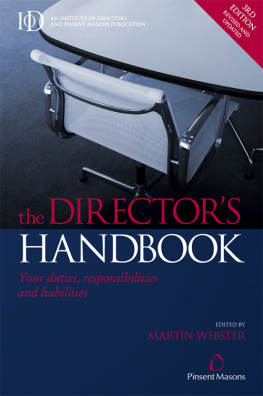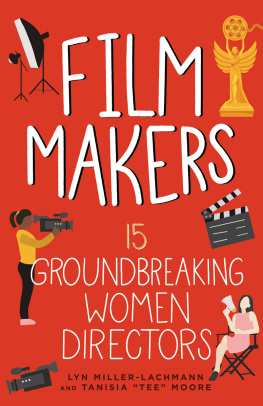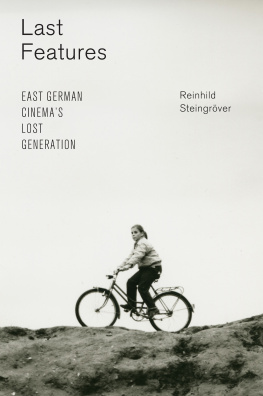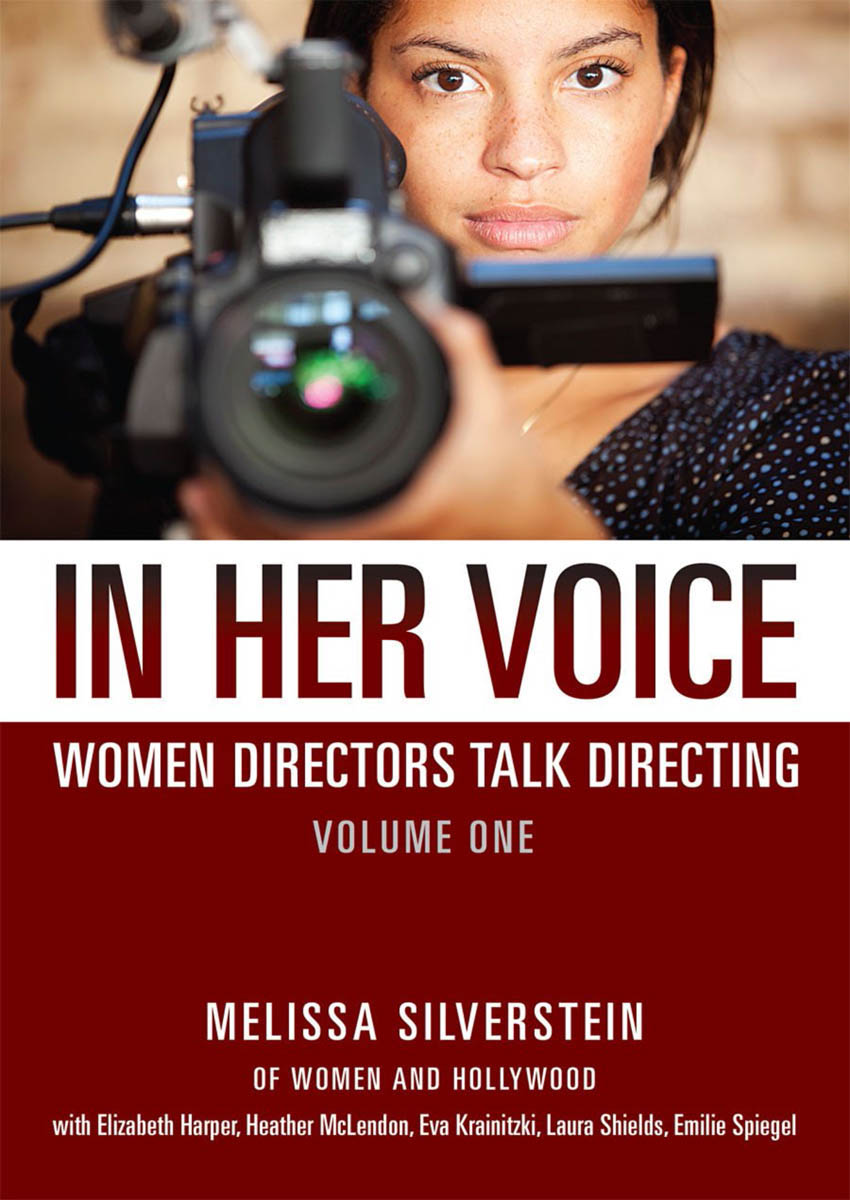Praise for In Her Voice
Women and Hollywood founder and feminist Melissa Silverstein has staked out her territory, and enriched the field, first with her blog and now with this smart, savvy collection of interviews with women directors... In Her Voice brings together first-hand accounts of what its like to be on the front lines of womens filmmakingand behind the camera, too.
Thelma Adams , Contributing Editor, Yahoo! Movies
Melissa Silversteins media-savvy collection of interviews is an eye-opener. So many talented and accomplished women can only pave the way for more. For me, the revelation is the extraordinary range of interests among these directors, and their incredible ingenuity in getting their projects to the screen. This enterprise fills a huge gap and, unlike a hard-copy book, which starts and stops, In Her Voice will be an ongoing record of information and celebration.
Molly Haskell, film critic and author, From Reverence to Rape: The Treatment of Women in the Movies (1974; revised and reissued in 1987) and Frankly, My Dear: Gone with the Wind Revisited
The contributions of women directors in Hollywood is one of the most over-looked and under-appreciated aspects of the film industry. Melissa Silverstein has compiled a fascinating and illuminating array of interviews of some of the most exciting voices of our time. Kudos :)
Angela Robinson, director, D.E.B.S., Herbie Fully Loaded
I have followed Melissas blog ever since she drove a petition to express outrage at the lack female driven films selected for the Cannes film festival this year. The tide is turning but every female director who gets to play ball in Hollywood from now on will owe a debt of gratitude to Melissas passionate activism on our behalf.
Rachel Ward, director, Beautiful Kate
Smart and uplifting, this book is a siren call to women to get behind the camera.
Kate Muir, Chief Film Critic of The Times UK
Melissa has created an incredibly inspiring piece for any filmmakernot only women. That said, Melissas book is a great source to learn from other womens experiences and perseverancefor the young or well seasoned!
Brenda Chapman, co-director, Brave
As a director who began making films in an era without any female role models in Hollywood, I wish I could have had this inspiring collection of interviews by women directors. Their collective experience and advice about the process sends an empowering and passionate message to any woman who wants to enter the business. Just go do it!
Chris Hegedus, co-director, The War Room
When I first started out making films back in the early 1980s you could count the number or women directing movies on one hand. Its encouraging that three decades later Melissa Silverstein has been able to compile an entire book of interviews with female filmmakers. Its about time someone chronicled this important but overlooked piece of cinema history. However, this is only Volume 1. Lets hope there will soon be Volumes 2 through 10.
Susan Seidelman, director, Desperately Seeking Susan, The Boynton Beach Club
There is strength in numbers and strength in these stories. Women directors need never feel alone again.
Cari Beauchamp, author of Without Lying Down, Frances Marion and the Powerful Women of Early Hollywood
In Her Voice is inspiring in the best, unsentimental sensesmart conversations with working directors who have forged ahead, defying obstacles, to create films that range from the visionary to the crowd-pleasing, and are sometimes both.
Caryn James, critic, Indiewire
In Her Voice
Women Directors Talk Directing
Melissa Silverstein
of Women and Hollywood
with Elizabeth Harper, Heather McLendon,
Eva Krainitzki, Laura Shields, Emilie Spiegel
All rights reserved, including without limitation the right to reproduce this ebook or any portion thereof in any form or by any means, whether electronic or mechanical, now known or hereinafter invented, without the express written permission of the publisher.
Copyright 2013 by Melissa Silverstein/Women and Hollywood
Front cover photo: ContentWorks.tv, www.istockphoto.com
ISBN: 978-1-5040-2381-8
Distributed in 2015 by Open Road Distribution
345 Hudson Street
New York, NY 10014
www.openroadmedia.com

Contents
Preface
All people have a click moment, an experience that deeply affects them and becomes embedded on their psyche. Ive heard many women talk about the moment they discovered they were a feminist. Not surprisingly, my click moment has to do with movies and feminism. When I was a teenager I discovered Barbra Streisand, first as a singer and then as an actress. I was sixteen when Yentl came out, and I begged my parentswho had no interest in seeing this filmto take me. I remember they drove me on a very cold night to the Syosset Theatre on Long Island to see this film that I was so excited about. (Thanks Mom and Dad.) I was the youngest in the theater by several decades, but I didnt care. I was transfixed throughout the entire movie.
The movie ended and people started to get up, but I stayed glued to my seat. As the credits rolled, I saw something that I had never seen before. A womans name everywhere. I probably had never thought about it, but seeing it had a profound effect on me. This woman was the producer, the director, the co-writer, the star and the singer. Whatever you might think about the film, you cant help but be impressed with the feat she accomplished. Getting this film made and directing it was not easy. After fifteen years of struggle, she finally got a green light at $14.5 million with the caveat that if it went over budget, Streisand would have to forgo part of her $3 million acting salary to cover the gap (it did go barely over budget to $16.2 million and she had to give back $1.5 million). [Barbra Puts Her Career on the Line With Yentland Learns New Lessons About Her Power and Her Femininity by Anne Fadiman.]
Looking back to 1983, Streisands Yentl was among other strong womens roles in film that year. It was the year of Silkwood and Terms of Endearment not to mention Flashdance, Educating Rita, and Heart Like a Wheel. Each of those movies is a classic. Terms of Endearment grossed more than $100 milliona sum almost unheard of in the 1980s. But the one thing to remember is that none of those movies, except Yentl, was directed by a woman. It was a time of very, very few women directors. It would be wonderful to say that we have progressed to a place thirty years later where what Streisand accomplished has become the norm.
It is true that now there are women working at all levels of the industry. But lets be real, while it is tough for all directors, it is tougher for women. The horrific statistics confirm the anecdotal evidence. Only 5 percent of the top 250 grossing films released in the United States in 2011 were directed by women. And no matter the perception that women have achieved a certain level of success, the numbers are actually getting worse, not better. Women directed 9 percent of films in 1998. Seven percent in 2006, and 7 percent in 2010. (For these statistics and many more, check out the Center for Study of Women in Television and Film at San Diego State University.) Women directors clearly do better in independent film. The latest statistics (from 201112) show that women made up 18 percent of narrative film directors and 39 percent of documentary directors of films screened at a large set of film festivals across the United States.







